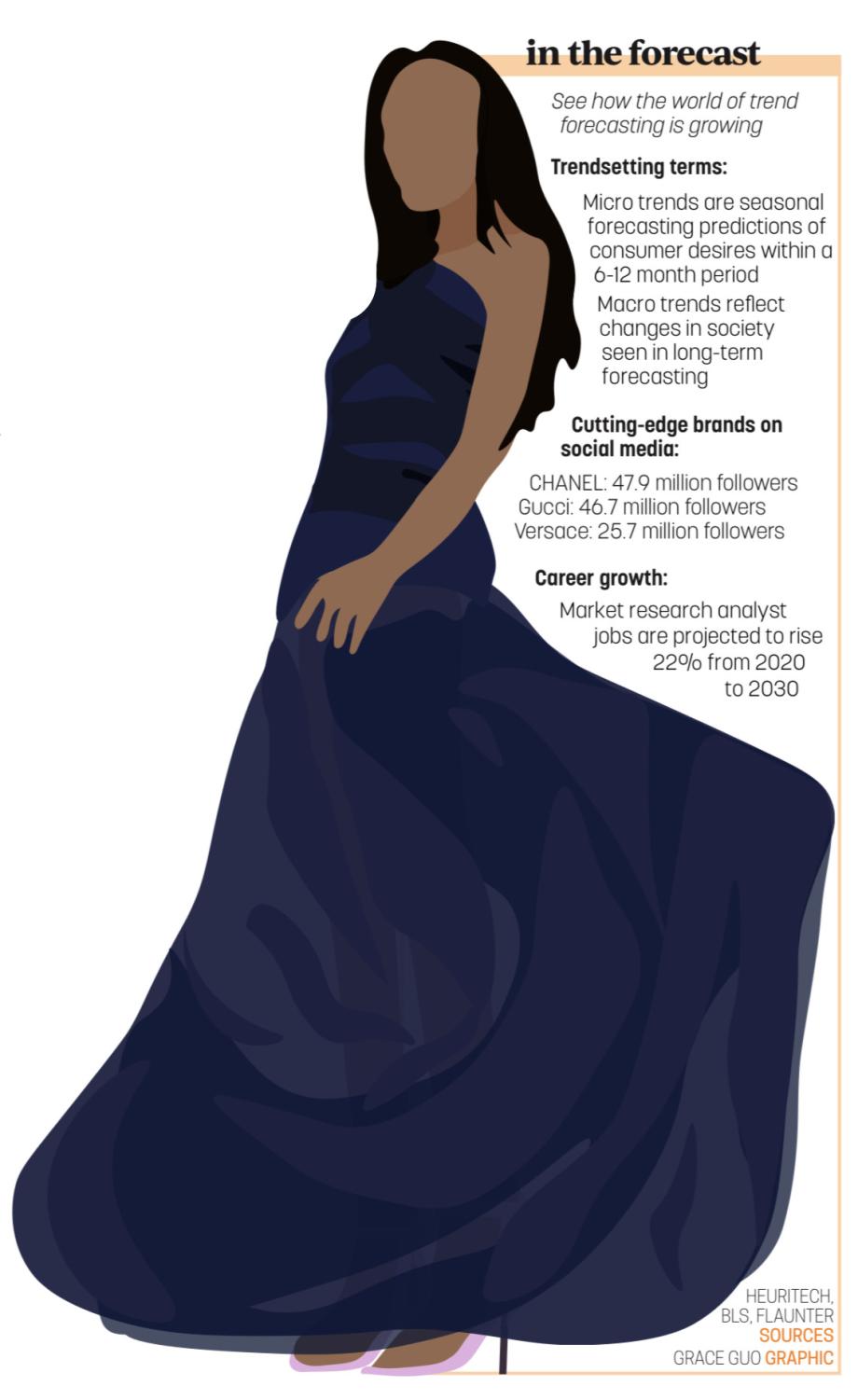Trend forecasting represents the intersection of statistics and economics; one of the most noticeable fields in which trend forecasting is increasing is the fashion industry. Feb. 10 to Feb. 14 will mark New York Fashion Week (NYFW) 2022, in which designers and brands will showcase designs for their fall/winter collections. Popular both in social media and locally at CHS, students plan to utilize trend forecasting when observing the runways of NYFW.
Junior Inia Narayanan said while trend forecasting is difficult because of the random, unpredictable nature of the fashion industry, one can foresee trends based on the cyclical nature of fashion through the years.
“A lot of trends grow on things that have already happened in the past. Although sometimes it can be randomized, analyzing trends that have happened in the past can really help with analyzing ones that will happen in the future,” she said. 
AP Statistics teacher Matthew Wernke said while some trends will not repeat because they directly relate to the socioeconomic climate of that time period, experts could use statistics to predict the more quantitative trends.
“Say you identify from the 1950’s to the 2000’s, each trend in each decade, and then you figure out when each trend recycles again,” he said. “You could say that on average each trend is repeating every 32 years and then have an idea of when today’s trends will be popular again. Well, maybe 32 years. So statistics can look at the numbers side of that.”
Dev Mathur, AP Statistics student and junior, said even without a knowledge of fashion history, it is possible to predict trends using statistical analysis.
He said, “Using specific statistical analysis you can definitely predict trends in any area of study that you want. I think fashion is definitely one example of that.”
Famously, a small group of young people in Soho saved Hush Puppies, classic American brushed-suede shoes with a lightweight sole, from extinction by starting a trend. The brand sold 30,000 pairs in 1994, but when designers Anna Sui and John Bartlett featured the shoe in their fall/winter 1995 collections, it sold 430,000 pairs the following year.
Narayanan said one can predict certain micro trends, like Hush Puppies, based on how aesthetics are generally changing in fashion.
“Do your research because the more information you have on call, you can kind of start to see what kinds of things have started to gain popularity,” she said. “I think even with chunky rings, you could have noticed that with things just being bigger as a whole. In terms of shoes, especially with Fila starting to popularize, I think the whole chunky trend in general could have been predicted.”
Wernke said predicting micro trends is highly subjective, and while students can research statistics to learn more and become increasingly accurate, they most likely already use trend forecasting in their daily lives.
He said, “Forecasting, obviously, is a statistics idea. We do statistics everyday. The idea that when you pull up to a stop light and you’re in a rush somewhere and there’s two lanes, sometimes you switch to the left lane because you think it’s going to go faster. You forecasted something, you forecasted traffic patterns in that case.”
However, Mathur said it’s dangerous to make predictions based solely on correlation and observations. He said learning statistics has taught him to carefully examine how other factors might affect trend forecasts.
“There are other variables in place. If there’re two variables associating with one another in regards to fashion, and because of that these trends are thought to be one variable causing another, that causes you to see false trends,” he said. “The addition of some lurking variable in the background could affect the trends we see in the fashion industry.”
Narayanan said she predicts several trends in the 2022 fashion industry, including more intricate hairstyles and puff sleeves. However, she said the ever-changing trends can be unsustainable.
“Although materialism does have its benefits and cons, small things like this definitely play into it. Almost for everyone, it is a form of expression,” she said. “Although their specific micro trends might not be as popular as others, I feel those who follow trends more regularly do play more into a materialistic culture, while micro trends as a whole aren’t really harmful to anyone.”
Wernke said people usually don’t consider statistics while making fashion choices, but that could change in the future with society’s increased emphasis on short-lived trends.
“If you’re worried about what people think about your fashion, you might start thinking ahead, what is it I could wear that will be the next trendy thing,” he said. “I think people do that all the time, they just don’t do it quantitatively. They’re not punching numbers in a calculator trying to figure out what’s going to occur next.”
Overall, Narayanan said while she enjoys forecasting trends and researching fashion, students should work to discover their personal style first.
“Although trends are important, I think adapting them to what you think is best for you is just as important for self expression.”



















![Joseph Broman, Mu Alpha Theta sponsor, grades tests for his honors precalculus/trigonometry class. Broman said, “I’m retiring from the Math Club next year and I’m just going to do Mu Alpha Theta so I can focus on that one and we can do more [speaker series] first semester.”](https://hilite.org/wp-content/uploads/2024/03/IMG_9502-1200x900.jpg)











![British royalty are American celebrities [opinion]](https://hilite.org/wp-content/uploads/2024/03/Screenshot-2024-03-24-1.44.57-PM.png)




















![Review: “The Iron Claw” cannot get enough praise [MUSE]](https://hilite.org/wp-content/uploads/2024/04/unnamed.png)
![Review: “The Bear” sets an unbelievably high bar for future comedy shows [MUSE]](https://hilite.org/wp-content/uploads/2024/03/unnamed.png)
![Review: “Mysterious Lotus Casebook” is an amazing historical Chinese drama [MUSE]](https://hilite.org/wp-content/uploads/2024/03/0.webp)
![Thea Bendaly on her Instagram-run crochet shop [Biz Buzz]](https://hilite.org/wp-content/uploads/2024/03/IMG_0165-1200x838.jpg)
![Review: Sally Rooney’s “Normal People,” is the best book to read when you are in a time of change [MUSE]](https://hilite.org/wp-content/uploads/2024/03/20047217-low_res-normal-people.webp)
![Review in Print: Maripaz Villar brings a delightfully unique style to the world of WEBTOON [MUSE]](https://hilite.org/wp-content/uploads/2023/12/maripazcover-1200x960.jpg)
![Review: “The Sword of Kaigen” is a masterpiece [MUSE]](https://hilite.org/wp-content/uploads/2023/11/Screenshot-2023-11-26-201051.png)
![Review: Gateron Oil Kings, great linear switches, okay price [MUSE]](https://hilite.org/wp-content/uploads/2023/11/Screenshot-2023-11-26-200553.png)
![Review: “A Haunting in Venice” is a significant improvement from other Agatha Christie adaptations [MUSE]](https://hilite.org/wp-content/uploads/2023/11/e7ee2938a6d422669771bce6d8088521.jpg)
![Review: A Thanksgiving story from elementary school, still just as interesting [MUSE]](https://hilite.org/wp-content/uploads/2023/11/Screenshot-2023-11-26-195514-987x1200.png)
![Review: When I Fly Towards You, cute, uplifting youth drama [MUSE]](https://hilite.org/wp-content/uploads/2023/09/When-I-Fly-Towards-You-Chinese-drama.png)
![Postcards from Muse: Hawaii Travel Diary [MUSE]](https://hilite.org/wp-content/uploads/2023/09/My-project-1-1200x1200.jpg)
![Review: Ladybug & Cat Noir: The Movie, departure from original show [MUSE]](https://hilite.org/wp-content/uploads/2023/09/Ladybug__Cat_Noir_-_The_Movie_poster.jpg)
![Review in Print: Hidden Love is the cute, uplifting drama everyone needs [MUSE]](https://hilite.org/wp-content/uploads/2023/09/hiddenlovecover-e1693597208225-1030x1200.png)
![Review in Print: Heartstopper is the heartwarming queer romance we all need [MUSE]](https://hilite.org/wp-content/uploads/2023/08/museheartstoppercover-1200x654.png)























![Review: Ladybug & Cat Noir: The Movie, departure from original show [MUSE]](https://hilite.org/wp-content/uploads/2023/09/Ladybug__Cat_Noir_-_The_Movie_poster-221x300.jpg)

![Review: Next in Fashion season two survives changes, becomes a valuable pop culture artifact [MUSE]](https://hilite.org/wp-content/uploads/2023/03/Screen-Shot-2023-03-09-at-11.05.05-AM-300x214.png)
![Review: Is The Stormlight Archive worth it? [MUSE]](https://hilite.org/wp-content/uploads/2023/10/unnamed-1-184x300.png)



